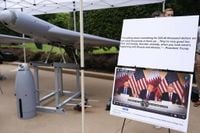The global defense landscape is rapidly evolving, with unmanned aerial vehicles (UAVs) or drones at the forefront of this transformation. From the United States to China, and across Europe and Ukraine, innovations in drone technology are reshaping military strategies and capabilities in unprecedented ways. Recent developments highlight a surge in demand, technological advancements, and strategic collaborations that are setting the stage for the future of warfare.
In the United States, AeroVironment (AVAV) is riding the wave of increasing demand for autonomous drones, reporting record fiscal year sales of $821 million, a 14% increase year-over-year. The company’s fourth-quarter revenue surged 40% to $275 million, fueled largely by its Switchblade loitering munitions, which accounted for 80% of the $138 million quarterly revenue within its Loitering Munition Systems segment. Sales in this segment jumped 87% year-over-year, underscoring the growing reliance on these systems for modern combat scenarios.
Over the past year, AeroVironment secured $477 million in funded contract awards for Switchblade, including a historic five-year sole-source Army IDIQ contract valued at nearly $1 billion. The company’s backlog has swelled to $726 million, up 82% from the previous year, indicating a robust pipeline of future sales. AeroVironment is also expanding its product portfolio with new offerings like the P550, Jump 20-X, and Red Dragon drones, each designed to meet diverse operational demands, from AI-driven autonomous missions to vertical take-off and landing capabilities on moving ships, and GPS-denied attack operations.
In May 2025, AeroVironment closed a $4.1 billion acquisition of BlueHalo, a move that broadens its reach into space, cyber, and directed energy warfare. BlueHalo’s estimated sales jumped from $660 million in 2021 to approximately $900 million in 2024, reflecting growing demand for its radio frequency counter-unmanned aerial systems, among other technologies. Following this acquisition, AeroVironment restructured its operations into two segments: Autonomous Systems and Space, Cyber, and Directed Energy. This strategic shift, coupled with strong sales and guidance, propelled AeroVironment’s stock price up 25% in June 2025, signaling investor confidence in its future trajectory. The company projects revenues between $1.9 billion and $2 billion for fiscal 2026, fueled by existing orders and new product demand.
Meanwhile, on July 16, 2025, the U.S. Department of Defense unveiled the Low-Cost Uncrewed Combat Attack System (LUCAS), developed by SpektreWorks. This new combat drone is designed to rival the Iranian Shahed-136, which has notably been used by Russia in its military operations. LUCAS is a cost-effective Group 3 Unmanned Aerial System featuring an open architecture that supports various payload integrations. It operates autonomously on the FLM 131 platform, equipped with a guidance system optimized for size, weight, and power efficiency. Notably, it supports multiple launch configurations, including Rocket-Assisted Take-Off (RATO), enabling easy deployment by non-specialized personnel. Additionally, LUCAS functions as a communication relay within the Multi-domain Unmanned Systems Communications (MUSIC) mesh network, ensuring secure communications among U.S. forces and allies. Having passed rigorous testing, LUCAS is now ready for production and deployment, marking a significant step in the U.S. effort to maintain technological superiority in drone warfare.
Across the Atlantic, Denmark’s Terma Group has partnered with Ukrainian drone manufacturer Odd Systems to co-develop a low-cost, AI-powered autonomous drone interceptor. This collaboration combines Terma’s expertise in advanced sensors, electronic warfare, and situational awareness with Odd Systems’ combat-proven drone platforms honed in the intense conditions of the Ukrainian battlefield. The joint effort aims to create a versatile interceptor capable of autonomously identifying, tracking, and neutralizing a wide spectrum of aerial threats, including FPV drones, ISR copters, fixed-wing reconnaissance drones, and long-range strike drones like the Shahed. Filip Rensch-Jacobsen, Vice President at Terma, emphasized the strategic value of this partnership, stating, “Collaborating with them is the smartest and most effective way forward.” Yaroslav Azhnyuk, co-founder of Odd Systems, echoed this sentiment, highlighting the importance of EU-Ukraine cooperation for European security.
Meanwhile, China demonstrated its growing drone capabilities during a live exercise on July 21, 2025, at a testing ground in Inner Mongolia. The exercise simulated the seizure and control of critical border locations using a full spectrum of domestically produced drone and counter-drone systems. The operation unfolded over six phases: reconnaissance, AI planning, infiltration, aerial attack, elimination, and anti-access. A highlight was the live-fire demonstration of the OW-5 anti-drone laser weapon, which successfully shot down a target drone several kilometers away using a high-energy beam barely visible to the naked eye. This upgraded OW5-A50 system, with a 50-kilowatt power output, integrates command and control, radar, electro-optical sensors, and a laser gun on an 8x8 Dongfeng heavy-chassis truck. It can operate independently or as part of a networked air defense system, showcasing China’s advancements in directed energy weapons and integrated battlefield systems.
Globally, the defense drone market is booming, driven by rapid military modernization and a shift toward more efficient, autonomous systems. According to market research, the global defense drone market was valued at approximately $10.12 billion in 2023 and is projected to grow to $11.22 billion in 2024. With a strong compound annual growth rate of 10.86%, the market is expected to reach an impressive $25.6 billion by 2032. This growth reflects the increasing reliance on drones for surveillance, reconnaissance, precision strikes, electronic warfare, and logistical support, transforming traditional combat doctrines.
Technological innovations such as artificial intelligence, machine learning, autonomous navigation, and stealth design are redefining drone capabilities. AI-powered drones can autonomously navigate complex environments, recognize targets, and adapt to battlefield changes, making them indispensable combat assets. Enhanced sensor suites, including high-resolution electro-optical/infrared cameras, radar, and electronic warfare equipment, further expand their operational versatility.
Countries worldwide are investing heavily in drone programs to strengthen their defense postures. The United States leads in technological development and procurement, but nations like China, India, Israel, Russia, and Turkey are rapidly advancing their indigenous drone capabilities. Many governments prefer domestic manufacturing to reduce dependency on foreign suppliers and safeguard sensitive technologies.
The expanding roles of drones now include electronic warfare, decoy operations, cargo resupply, anti-submarine warfare, mine detection, and communication relays. Emerging concepts such as drone swarms and loitering munitions are reshaping battlefield tactics, providing new strategic advantages. Integration with manned platforms and command systems is enhancing battlefield coordination, reflecting a holistic approach to modern warfare.
These developments underscore a global trend: the future of defense is increasingly unmanned, connected, and autonomous. As military forces adapt to new security challenges, drones are becoming central to maintaining strategic superiority, reducing operational risks, and enhancing situational awareness across all domains of warfare.





